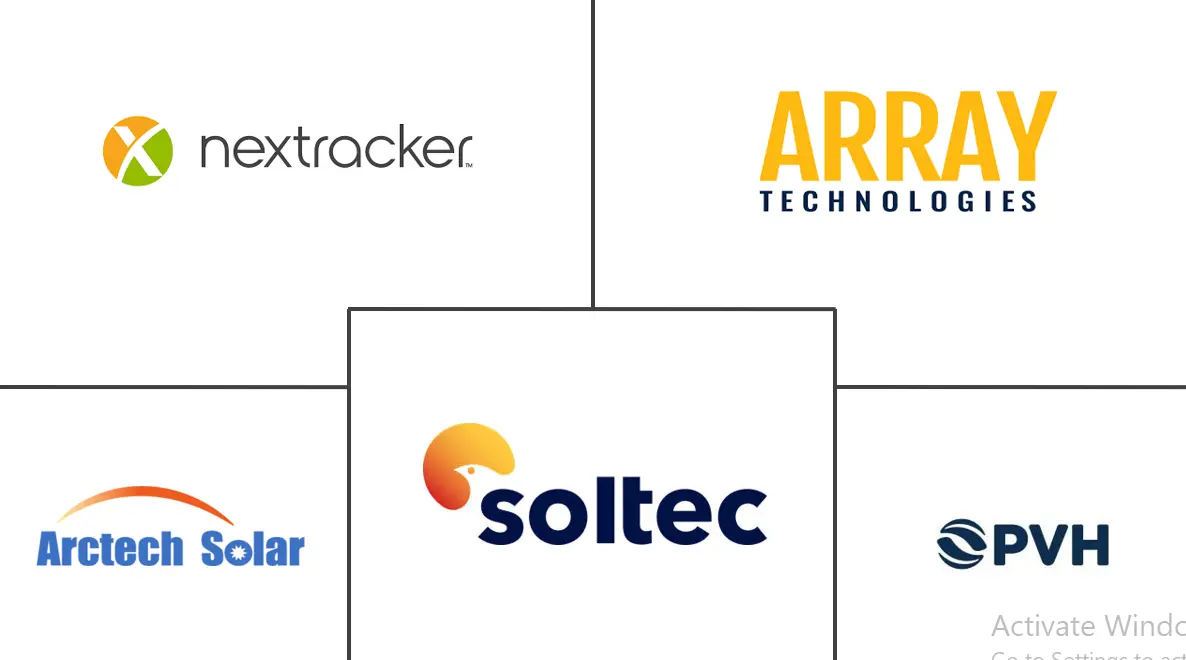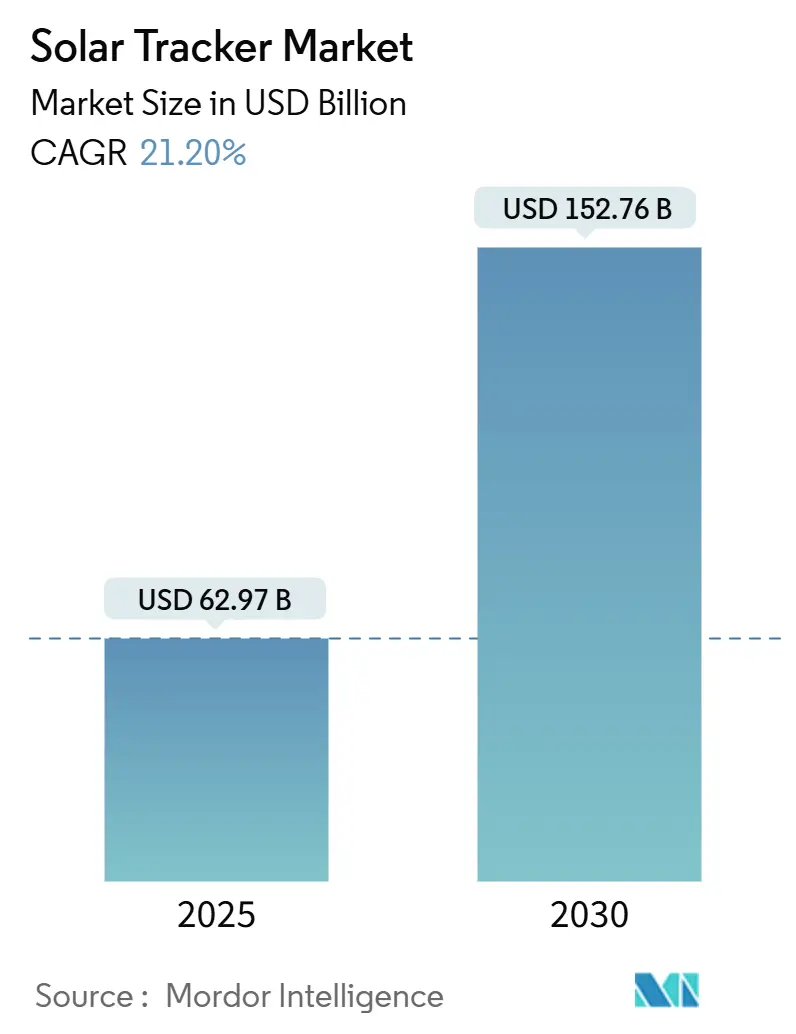
Solar Tracker Market Analysis by Mordor Intelligence
The Solar Tracker Market size is estimated at USD 62.97 billion in 2025, and is expected to reach USD 152.76 billion by 2030, at a CAGR of 21.20% during the forecast period (2025-2030).
The sharp rise is underpinned by steady panel price declines, policy-led investment flows, and the need to lift energy yield from utility-scale projects through precise tracking. Single-axis architectures retain cost advantages, while bifacial modules paired with trackers raise internal rates of return by 2-4% in high-albedo zones. In North America, the Inflation Reduction Act has already triggered USD 124 billion in clean-energy spending that includes multi-gigawatt tracker contracts.[1]Business Council for Sustainable Energy, “Sustainable Energy in America Factbook 2025,” bcse.org Asia-Pacific follows as the fastest-growing region on the back of China’s manufacturing strength and India’s domestic-content incentives. Meanwhile, elevated steel prices and shortages of operations crews keep margin pressure high, prompting design shifts toward lighter single-post systems and smarter actuators.
Key Report Takeaways
- By axis type, single-axis units captured 53% of the solar tracker market share in 2024; dual-axis systems are advancing at a 22% CAGR through 2030.
- By technology, photovoltaic platforms commanded 85% of the solar tracker market size in 2024; concentrated photovoltaic is expanding at a 26% CAGR to 2030.
- By application, utility-scale assets accounted for 82% of the solar tracker market size in 2024, while commercial & industrial sites post a 19% CAGR to 2030.
- By drive type, electric-motor designs held 78% revenue share in 2024; hydraulic drives led growth at a 23% CAGR between 2025-2030.
- By geography, North America led with a 73% solar tracker market share in 2024; Asia-Pacific records the fastest 21.73% CAGR over the forecast window.
- Nextracker, Array Technologies, and Arctech Solar held 49% of the 2024 global revenue.
Global Solar Tracker Market Trends and Insights
Drivers Impact Analysis
| Driver | (~) % Impact on CAGR Forecast | Geographic Relevance | Impact Timeline |
|---|---|---|---|
| U.S. IRA-fuelled utility-scale PPAs | +5.20% | North America; spillover to Europe | Medium term (2-4 years) |
| 1P modular design cap-ex savings | +3.70% | Asia-Pacific; Middle East & Africa | Short term (≤ 2 years) |
| Bifacial-optimised trackers in high-albedo sites | +4.30% | South America; Europe | Medium term (2-4 years) |
| 24/7 renewable procurement by cloud & mining firms | +2.90% | North America; global expansion | Medium term (2-4 years) |
| EU REPower Acceleration of Agrivoltaics—Slim-Row Trackers for Cropland | +3.1% | Europe, with adoption spreading to North America | Long term (≥ 4 years) |
| Grid–Forming Storage-Coupled Projects Pushing Dual-Axis Adoption in Australia | +2.0% | Asia-Pacific, with potential expansion to North America | Medium term (2-4 years) |
| Source: Mordor Intelligence | |||
U.S. IRA-fuelled Utility-Scale PPAs Unlocking Multi-GW Tracker Contracts
Federal incentives cut utility-scale solar capital cost and lengthen visibility on cash flows. Power-purchase agreement volumes have risen 56% since 2022, enlarging backlogs for tracker makers. A 30% investment-tax credit plus domestic-content bonuses favours suppliers with U.S. plants, demonstrated by Nextracker’s first fully domestic tracker shipment in December 2024.[2]Renewable Energy World, “First Fully U.S.-Made Solar Trackers Shipped,” renewableenergyworld.com Projected solar deployment gains reach 48% over the decade, broadening tracker demand across inter-tie zones.
Diminishing Tracker Cap-Ex per MW via 1P Modular Designs in India & MENA
Single-post modular frames shave steel tonnage by up to 30%, countering raw-material inflation that drives 65% of tracker cost. India’s policy for local value added enables 95% domestic content on 10 GW of Nextracker deployments. Similar savings emerge in desert sites across MENA where lightweight foundations ease logistics and shorten installation cycles.
Bifacial-Optimised Trackers Raising IRR in High-Albedo Regions
Rear-side irradiance pickup lifts energy yield 5-20% relative to monofacial arrays. In Chile’s Atacama Desert, IRR climbs 4% when bifacial modules mount on single-axis rows with reflective salt-flat sub-grade. AI-driven tracking algorithms using adaptive neuro-fuzzy inference further heighten angular accuracy, returning 57% extra energy versus fixed racks. The performance premium outweighs incremental structure outlay in land-constrained or high-price markets.
Aggressive 24/7 Renewable Procurement by U.S. Cloud & Mining Firms
Data-center and crypto-mining growth intensifies round-the-clock renewable sourcing. Integrated battery storage paired with trackers now forms the default specification, supporting grid services and lifting capacity factors. Electricity demand from U.S. data centres could grow 9% by 2028. Concurrently, the Department of Energy targets up to 160 GW of virtual power plants that lean on flexible tracker-plus-storage fleets.
Restraints Impact Analysis
| Restraint | (~) % Impact on CAGR Forecast | Geographic Relevance | Impact Timeline |
|---|---|---|---|
| Elevated Structural Steel Prices & Section 232 Tariffs in North America | -2.8% | North America, with secondary effects in Europe | Short term (≤ 2 years) |
| Tracker Failure Risk on Frost-Heave Sites—Nordic & Alpine Utility Farms | -1.5% | Europe, with similar challenges in northern North America | Medium term (2-4 years) |
| Scarcity of Skilled O&M Crews for Decentralized Actuators in SSA | -1.7% | Sub-Saharan Africa, with similar challenges in parts of South Asia | Medium term (2-4 years) |
| Bankability Concerns for New Chinese Entrants Without IEC 62817 Testing | -1.3% | Global, with particular impact in emerging markets | Short term (≤ 2 years) |
| Source: Mordor Intelligence | |||
Elevated Structural Steel Prices & Section 232 Tariffs in North America
Hot-rolled coil prices remain above USD 900 per tonne, squeezing tracker margins. Section 232 tariffs compound the burden for imported steel. Manufacturers counter by vertically integrating foundations; Nextracker bought Solar Pile International in August 2024 to secure supply.[3]PV Tech, “Nextracker Buys Solar Pile International,” pv-tech.org Design simplification through single-axis geometry also lowers steel intensity yet does not eliminate exposure when tariffs persist.
Tracker Failure Risk on Frost-Heave Sites—Nordic & Alpine Utility Farms
Seasonal soil uplift can misalign torque tubes and binding points. Dual-axis systems face higher sensitivity, raising maintenance cost and downtime. Mitigation includes helical pile foundations and fold-flat stow positions that shed snow; the FLAP PV design reports 30% higher yield under harsh winters. However, the extra engineering elevates installed price, delaying adoption until energy price signals justify the spend.
Segment Analysis
By Axis Type: Single-Axis Retains Lead while Dual-Axis Gains Specialist Demand
Single-axis racks held 53% of solar tracker market share in 2024 and generated a 15-25% energy uplift over fixed-tilt baselines at modest capital premium. Broader utility acceptance stems from easier maintenance schedules and fewer moving parts, which align with labour-scarce markets. Cost compression through one-post frames keeps unit price stable despite steel inflation. Meanwhile, dual-axis products post a 22% CAGR to 2030 as high-latitude grids and storage-coupled islands seek highest possible yield. AI-enabled orientation algorithms push accuracy near 0.3° deviation, narrowing irradiance loss and shortening payback in premium-tariff zones.
Dual-axis solutions lift production 30-40% against fixed arrays, benefiting land-constrained projects where extra output offsets added mechanics. Enhanced snow-shed and soiling-avoidance features reduce downtime across Nordic farms. Manufacturing scale-up and modular drives are closing the historical cost gap, with several suppliers targeting sub-USD 0.08 per watt ex-works for dual-axis kits by 2027. As wholesale market volatility rises, independent power producers weigh dual-axis trackers to capture elevated peak-hour pricing, particularly in grids with limited hydro balancing capacity.
By Technology: Photovoltaic Dominates as Concentrated Photovoltaic Accelerates
Photovoltaic modules controlled an 85% share of the solar tracker market size 2024, underwritten by more than 1,000 GW of global manufacturing nameplate capacity. Supply resilience and predictable learning curves sustain widespread adoption across mature utility procurement frameworks. Module efficiencies routinely surpass 22%, allowing project designers to focus tracker selection on structural optimization and grid-integration features. Concentrated photovoltaic occupies a niche yet expands at a 26% CAGR to 2030, driven by 40% cell conversion efficiencies under high direct-normal irradiance. Projects in the Maghreb, Southwestern United States, and northern Mexico blend CPV optics with precise dual-axis mechanics to unlock superior land-use productivity.
Emerging research shows hybrid PV-CPV fields that anchor CPV islands inside broader PV swaths to hedge irradiance variance while boosting aggregate yield. Tracker algorithms adapt to dual sensor inputs, blending DNI and global horizontal irradiance datasets to fine-tune orientation. As policymakers reward dispatchable solar under mid-duration storage mandates, CPV’s higher temperature coefficient and elevated voltage windows enhance battery-coupling economics. Manufacturers active in this segment pursue ruggedised drives tolerant to higher stow frequencies triggered by wind events, preserving annual availability above 99%.
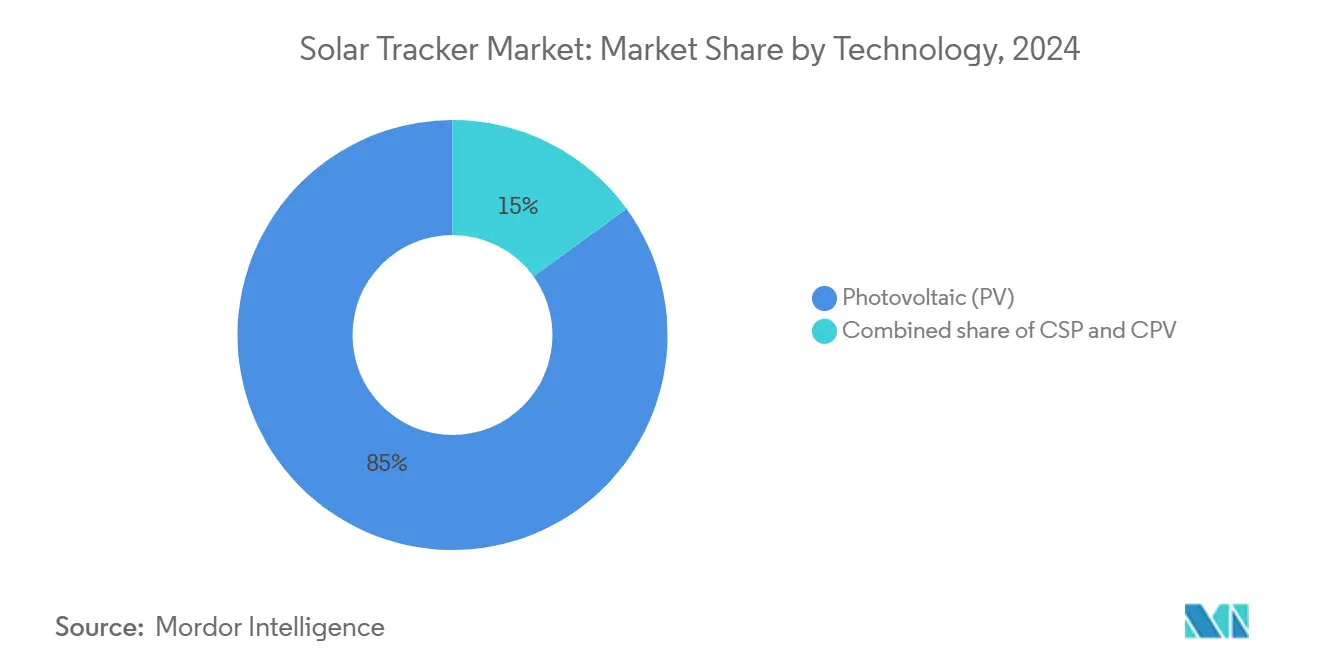
Note: Segment shares of all individual segments available upon report purchase
By Application: Utility-Scale Prevails while Commercial & Industrial Accelerates
Utility-scale contracts represented 82% of the solar tracker market size in 2024 as economies of scale align with bankability tests demanded by project finance lenders. Tracker shipments to utility projects are forecast to rise 15% annually through 2025, giving trackers a 55% share of global installations outside China. Developers favour 1P single-axis designs that fit megawatt-block civil workflows and integrate seamlessly with DC-coupled storage. Conversely, the commercial & industrial segment grows at a 19% CAGR to 2030, reflecting corporate net-zero programmes and tariff parity in behind-the-meter settings. Roof-top constraints spur demand for lightweight, low-profile trackers operating within structural load limits.
Agrivoltaics is a complementary niche where horizontal single-axis rows minimise shading time over crop canopies. More than 600 U.S. agrivoltaic sites totalling 10 GW use tracker layouts that balance diffuse light for crops and direct light for modules. Remote micro-grids in high-irradiance islands also trial dual-axis platforms to maximise daily harvest, evidenced by a New Cairo test system hitting an LCOE of USD 0.153 per kWh. Increasing policy support for localised energy resilience suggests micro-grids will adopt trackers as control software matures and real-time pricing signals spread.
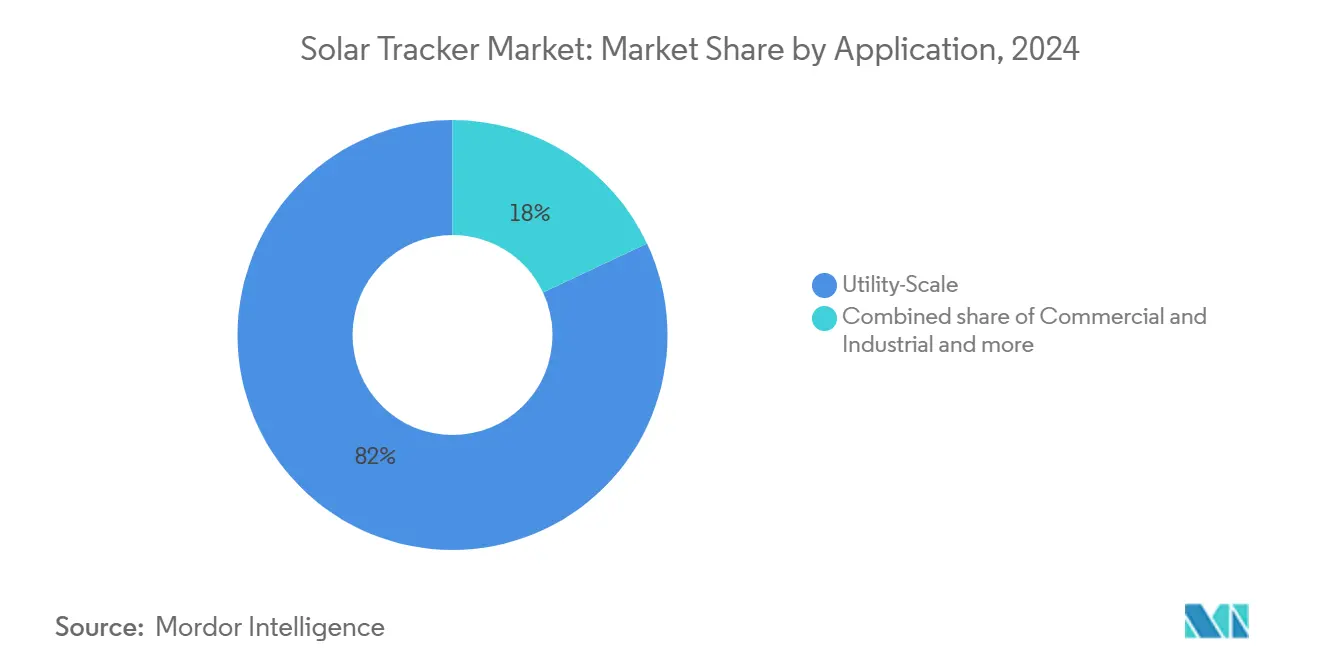
Note: Segment shares of all individual segments available upon report purchase
By Drive Type: Electric Motors Dominate as Hydraulic and Linear Actuators Rise
Electric motors account for 78% of tracker drives because of precise motion control, compact gearboxes, and broad field service familiarity. Component modularity lowers inventory holding cost for operators and supports rapid swap-out in event of failure. Vendors have trimmed no-load power draw beneath 0.01% of array output, improving lifetime energy yield metrics. Hydraulics, advancing at a 23% CAGR, find traction where high torque and wind stow responsiveness outweigh additional fluid maintenance. A dual-axis hydraulic concept from King Fahd University showed 15% lower energy consumption relative to equivalent gearbox units under desert test conditions.
Linear actuators, especially ball-screw designs, present another growth vector due to high positional accuracy and fewer lubrication cycles. Field trials indicate over 25% generation gain when linear drives replace fixed racking at 30° latitude. Pneumatic actuators register promising prototyping results, logging up to 66% efficiency improvement on dual-axis benches with minimal parasitic loss. Component choice increasingly correlates with local environmental stresses; cold-weather sites pivot toward servo-electric drives with low-temperature grease, whereas sand-storm zones trial hermetically sealed hydraulic pistons.
Geography Analysis
North America led the solar tracker market with a 73% revenue share in 2024 as the Inflation Reduction Act enriched project margins and rewarded domestic manufacturing. The United States alone recorded USD 4.13 billion in tracker sales that year, while local suppliers launched full-content systems to secure bonus credits [4]Business Council for Sustainable Energy, “Sustainable Energy in America Factbook 2025,” bcse.org. Tracker adoption also benefits from soaring data-centre-driven demand peaks and widespread pairing with four-hour lithium storage, which smooth grid ramps and raise capacity value.
Asia-Pacific shows the fastest 21.73% CAGR to 2030. China’s dominance across ingot, wafer, and module stages spills into tracker component sourcing, keeping lead times low and pushing export offers into Latin America and Africa. India’s 10 GW deployment milestone by May 2025 underscores indigenous supply chains that meet 95% local-content thresholds, aided by import duties on finished modules. Australia, facing retirements of aging coal assets, opts for dual-axis grid-forming projects that feed synchronous inverters and heighten system strength in weak-grid pockets.
Europe’s market expands steadily as REPower targets accelerate solar permitting and prioritise dual land use. Slim-row trackers enable agrivoltaic farms in France, Italy, and Spain to mitigate crop shadow impacts while boosting rural incomes. Poland and Greece add gigawatt-scale pipelines supported by recovery-fund incentives, and high-latitude Nordics pilot fold-flat dual-axis arrays engineered for frost-heave mitigation.
Sub-Saharan Africa experiences sporadic yet rising tracker adoption tied to independent power projects in South Africa, Kenya, and Namibia. Labour shortages for actuator maintenance constrain scale-up, prompting trials of self-lubricating drives and remote diagnostics. South America, led by Chile and Brazil, installs bifacial-optimised trackers that capture albedo from desert soils and agrarian pastures, yielding IRR lifts that attract pension-fund capital.
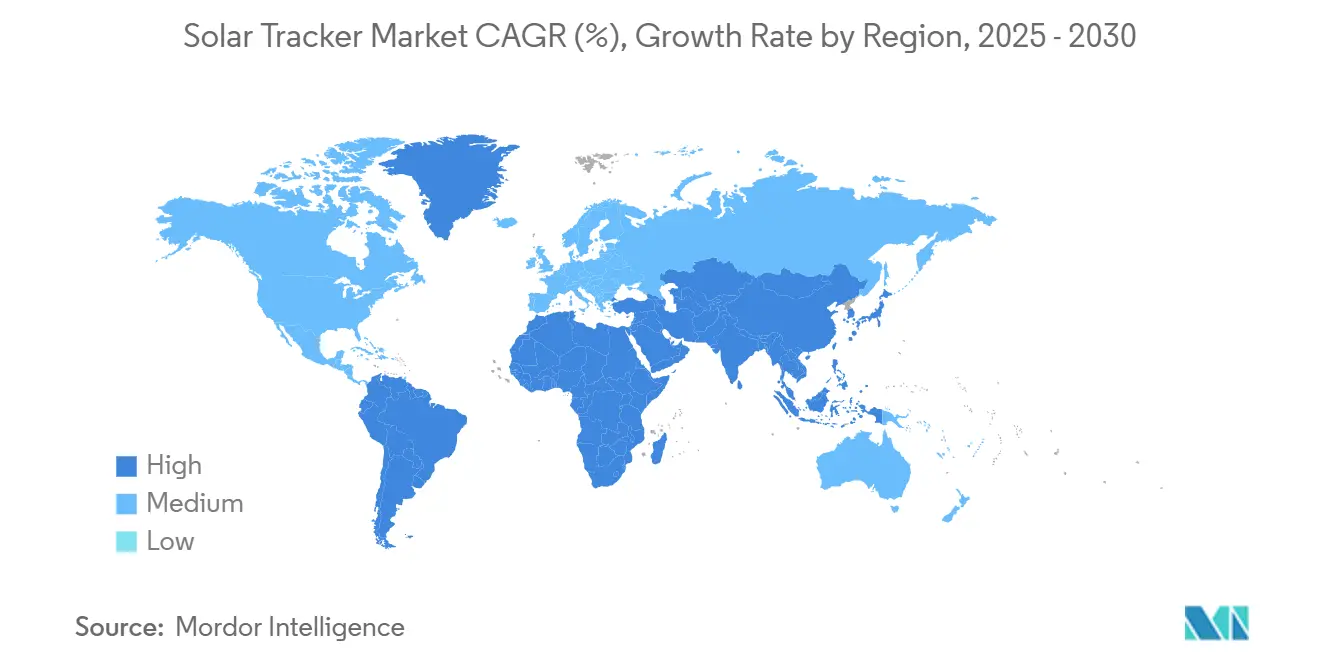
Competitive Landscape
Market concentration remains moderate; Nextracker commands major share of the global revenue, Array Technologies and Arctech Solar are other major companies in the market. Nextracker booked USD 1.4 billion revenue in the first half of FY2025 after expanding its domestic footprint through acquisitions of Ojjo and Bentek, thereby integrating foundations and power electronics. Array Technologies emphasises mechanical simplicity to lower steel content and pursued OEM alliances with torque-tube suppliers to hedge tariff exposure. Arctech leverages supply-chain flexibility from Chinese plants to underbid rivals in Central Asia and the Middle East, proven by a 2.3 GW Saudi award in November 2024.
Second-tier players such as PV Hardware, GameChange Solar, and Soltec gain share in price-sensitive regions through regionalised manufacturing. PV Hardware’s 5 GW U.S. tracker pool qualifies for safe-harbour rules, shielding clients from policy shifts. GameChange surpassed 37 GW cumulative deliveries and trials smart-stow modes triggered by satellite wind forecasts to cut storm damage losses. Soltec’s integrated development arm aligns tracker sales with project pipelines, supporting a 12.6 GW backlog across Iberia and Latin America.
Technology differentiation pivots on digital twins, predictive maintenance, and grid services. Vendors embed IoT sensors that relay torque and inclination data to cloud dashboards, enabling 99.5% uptime service-level agreements. Machine-learning orientation models reduce row-to-row shading by forecasting cloud cover and adjusting backtracking angles in real time. As domestic content mandates spread, competitive advantage increasingly hinges on proximity to steel mills, inverter hubs, and polymer extrusion lines.
Solar Tracker Industry Leaders
-
NEXTracker Inc.
-
Array Technologies Inc.
-
Arctech Solar Holdings
-
Soltec Power Holdings
-
PV Hardware (Power Electronics Group)
- *Disclaimer: Major Players sorted in no particular order
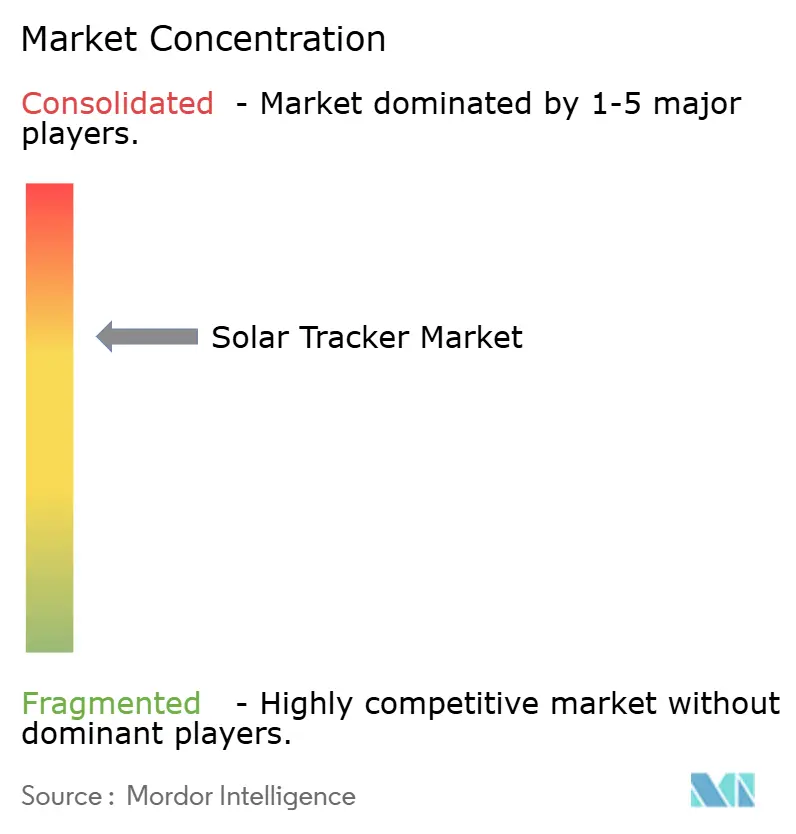
Recent Industry Developments
- May 2025: Nextracker added an electrical balance-of-system range to its platform, offering turnkey solutions for utility projects.
- May 2025: Nextracker acquired Bentek to extend power-distribution capability inside its tracker portfolio.
- November 2024: Arctech shipped SkyLine II trackers for a 320 MW Uzbek plant and won 2.3 GW in Saudi projects.
- August 2024: Nextracker acquired Solar Pile International to strengthen foundation supply security.
Research Methodology Framework and Report Scope
Market Definitions and Key Coverage
Our study defines the global solar tracker market as all revenue generated from supplying, installing, retrofitting, and servicing single-axis and dual-axis tracking systems used in ground-mounted PV, CPV, and CSP plants. Systems covered include steel structures, actuators, sensors, controllers, and tracker-specific SCADA layers.
Scope exclusion: Rooftop kits, tracker-inverter skid packages, and miniature consumer gadgets are not assessed.
Segmentation Overview
- By Axis Type
- Single Axis
- Dual Axis
- By Technology
- Photovoltaic (PV)
- Concentrated Solar Power (CSP)
- Concentrated Photovoltaic (CPV)
- By Application
- Utility-Scale
- Commercial and Industrial
- Residential and Micro-grid
- Agrivoltaics/Agri-solar
- By Drive Type
- Electric Motor
- Linear Actuator
- Hydraulic
- By Geography
- North America
- United States
- Canada
- Mexico
- Europe
- United Kingdom
- Germany
- France
- Spain
- Nordic Countries
- Russia
- Rest of Europe
- Asia-Pacific
- China
- India
- Japan
- South Korea
- Malaysia
- Thailand
- Indonesia
- Vietnam
- Australia
- Rest of Asia-Pacific
- South America
- Brazil
- Argentina
- Colombia
- Rest of South America
- Middle East and Africa
- United Arab Emirates
- Saudi Arabia
- South Africa
- Egypt
- Rest of Middle East and Africa
- North America
Detailed Research Methodology and Data Validation
Primary Research
Targeted interviews with tracker makers, EPCs, developers, and steel suppliers across North America, Europe, Asia-Pacific, and the Middle East helped us validate adoption ratios, landed ASPs, and expected torque-tube redesigns. Online surveys with utility buyers clarified service bundles and replacement cycles that are often absent from public data.
Desk Research
First, Mordor analysts mapped yearly demand using public datasets such as IEA monthly PV additions, IRENA capacity statistics, US EIA Form 860, Eurostat PRODCOM, and customs flows parsed via Volza. Policy context and average selling prices were cross-checked against SolarPower Europe briefs, DOE SunShot archives, and peer-reviewed journals. Company filings gathered through D&B Hoovers, news curated on Dow Jones Factiva, and patent counts from Questel clarified vendor revenues and design shifts. The sources cited are illustrative; many additional references supported data checks throughout the build.
Market-Sizing & Forecasting
The core model begins with a top-down rebuild of annual utility-scale PV additions by country, multiplies them by region-specific tracker penetration and calibrated ASPs, then contrasts totals with sampled supplier roll-ups and project bills to fine-tune gaps. Key variables like global utility PV build (GW), single-axis share, steel price index, bifacial module uptake, and tracker lifespan feed a multivariate regression overlaid with ARIMA smoothing for 2026-2030 scenarios.
Data Validation & Update Cycle
Outputs pass variance checks, peer reviews, and anomaly reconciliation before sign-off. Mordor refreshes every twelve months, with interim updates triggered when capacity outlooks shift by ±5% or a major policy shock occurs, ensuring clients receive our latest view.
Why Mordor's Solar Tracker Baseline Deserves Confidence
Published values diverge because firms mix distinct service baskets, currencies, and refresh cadences.
By locking scope early and revisiting variables each year, Mordor Intelligence keeps its baseline dependable for capital planning. Key gap drivers include whether retrofit and O&M revenue is counted, if control software is bundled, the treatment of regional price escalation, and exchange rate freeze points.
Benchmark comparison
| Market Size | Anonymized source | Primary gap driver |
|---|---|---|
| USD 62.97 B (2025) | Mordor Intelligence | - |
| USD 50.10 B (2024) | Global Consultancy A | Omits retrofit & O&M; 2024 FX frozen |
| USD 10.32 B (2024) | Global Consultancy B | Hardware only for new builds; ignores small dual-axis sites |
| USD 7.01 B (2024) | Research Publisher C | Limited geography and conservative uptake ratio |
These comparisons show that once scope breadth, currency alignment, and tracker uptake assumptions are harmonized, Mordor's figure offers the balanced, transparent baseline decision-makers need.
Key Questions Answered in the Report
What is the current value of the solar tracker market?
The solar tracker market is worth USD 62.97 billion in 2025 and is projected to reach USD 152.76 billion by 2030.
Which region leads solar tracker adoption today?
North America accounts for 73% of 2024 global revenue, driven largely by U.S. policy incentives that boost utility-scale roll-outs.
How fast is Asia-Pacific expected to grow?
Asia-Pacific registers the fastest 21.73% CAGR through 2030 as China and India expand domestic manufacturing and deployment.
Why are single-axis trackers more common than dual-axis systems?
Single-axis designs balance a 15-25% energy gain with lower capital outlay and simpler maintenance, making them attractive for large utility projects.
Which technology segment is growing the quickest?
Concentrated photovoltaic, though still small, is growing at a 26% CAGR due to high efficiency in direct-sun regions.
How do rising steel prices affect tracker economics?
Steel makes up about 65% of tracker cost; tariffs and high prices compress margins and spur design shifts to lighter single-post frames.
Page last updated on:
